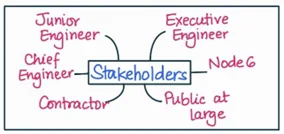Answer:
| Approach:
Introduction
Body
- Analyze each of the options with merits and demerits.
Conclusion
|
Introduction:
The Executive Engineer faces a dilemma of addressing serious deviations in a flyover construction.

Body:
Option (i) Follow the advice of the Chief Engineer and go ahead.
Merits:
- It aligns with the Chief Engineer’s opinion, maintaining a harmonious working relationship and avoiding potential conflicts.
- It prioritizes the completion of the project within the given timeframe, meeting the public demand and reducing traffic congestion.
- It avoids additional expenses and delays associated with demolition and rework.
Demerits:
- It compromises public safety by neglecting the serious deviations and lacunae that could potentially lead to accidents or structural failures.
- It undermines professional ethics and integrity by overlooking the need for adherence to design specifications and safety standards.
- It may expose the organization and individuals involved to legal liabilities and reputational damage if accidents or failures occur.
Option (ii) Make an exhaustive report of the situation bringing out all facts and analysis along with your own viewpoints stated clearly and seek written orders from the Chief Engineer.
Merits:
- It upholds professional integrity and responsibility by documenting the deviations and potential safety risks in a comprehensive report.
- It ensures that your concerns are properly communicated and recorded, providing evidence of your commitment to public safety.
- By seeking written orders, it clarifies the responsibility of the Chief Engineer and establishes a clear line of accountability.
Demerits:
- It may create tension and conflicts with the Chief Engineer who may feel challenged or threatened by the report’s findings and recommendations.
- It could result in delays and additional expenses if the Chief Engineer does not respond promptly or disagrees with the need for corrective actions.
- It may require additional efforts to convince the Chief Engineer and other stakeholders of the urgency and importance of addressing the deviations.
Option (iii) Call for explanation from the Junior Engineers and issue orders to the contractor for necessary correction within the targeted time.
Merits:
- It addresses the immediate issue by holding the Junior Engineers accountable for their oversight and directing the contractor to rectify the deviations.
- It demonstrates your proactive approach in ensuring that corrective actions are taken promptly to mitigate safety risks.
- It maintains a sense of authority and control over the project by actively engaging with the responsible parties.
Demerits:
- It may not address the underlying systemic issues that led to the deviations, such as lack of proper supervision or adherence to quality control measures.
- It relies on the cooperation and competence of the Junior Engineers and contractor to effectively rectify the deviations within the targeted time.
- It may not fully address the concerns raised in the exhaustive report and may be seen as a partial solution rather than a comprehensive response to the problem.
Option (iv) Highlight the issue so that it reaches superiors above the Chief Engineer.
Merits:
- It escalates the matter to higher authorities who may have a broader perspective and the power to enforce corrective actions.
- It brings attention to the serious deviations and safety risks, increasing the likelihood of appropriate measures being taken.
- It provides a mechanism for independent evaluation and intervention, reducing the influence of the Chief Engineer’s opinion.
Demerits:
- It may bypass the immediate superior, the Chief Engineer, leading to strained relationships and potential professional consequences.
- It may take time for the issue to reach higher authorities and for them to intervene, resulting in potential project delays and safety risks persisting in the interim.
- It may create a sense of distrust and undermine the hierarchy and chain of command within the organization.
Option (v) Considering the rigid attitude of the Chief Engineer, seek transfer from the project or report sickness.
Merits:
- It allows you to distance yourself from the project and potential ethical dilemmas, prioritizing your personal well-being and professional integrity.
- It provides an opportunity to seek alternative assignments or roles where you can make a positive impact and work in a more supportive environment.
Demerits:
- It may be perceived as an escape or avoidance strategy rather than actively addressing the issue and advocating for public safety.
- It may hinder your career growth and reputation if seen as a lack of commitment or inability to handle challenging situations.
- It may not contribute to resolving the problem at hand and may leave the project without someone actively monitoring and addressing the deviations.
Conclusion:
Considering the detailed evaluation, option (ii)
- Making an exhaustive report of the situation bringing out all facts and analysis along with your own viewpoints stated clearly and seek written orders from the Chief Engineer remains the most appropriate course of action.
- It upholds professional integrity, prioritizes public safety, and establishes a clear record of your concerns.
- Seeking written orders ensures that the responsibility lies with the Chief Engineer and provides a documented trail of accountability.
- While it may involve challenges and potential conflicts, it is the ethically responsible and transparent approach to address the serious deviations in the construction project.
